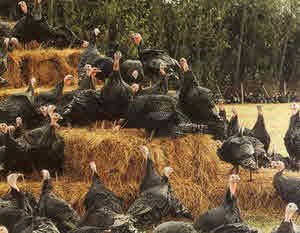 Breeding Turkeys
Breeding Turkeys
There are three ways in which turkeys are kept on a small scale. Some of these will involve breeding turkeys on-site. The turkey enterprises may be differentiated as follows:
- Farmers and smallholders who buy in poults during the summer to rear for the Christmas market.
- Breeders who raise their own turkeys for the market and sell the surplus poults.
- Enthusiasts who keep and breed traditional coloured turkey breeds for interest and showing.
Turkeys can be classified by their breeds or plumage colour, and by their type, as there are within some breeds, large, medium and small birds that finish at different weights.
Genetic Factors Affecting Turkeys
Plumage colour, body conformation, breast width and egg production are genetic factors that pass from one generation to another. Both body conformation and egg size are of good heritability and can be improved with selected breeding. Egg production and hatchability are of low heritability so these factors can only be improved over time with family breeding and individual selection.
Some plumage colours are dominant and others recessive. For example, black turkeys mated with bronze produce black offspring. If these offspring are then mated together, their offspring will be either black or bronze.
Although black plumage is dominant to bronze, the latter is dominant to any plumage colour other than black. So, if bronze turkeys are mated with another colour their progeny will all be bronze. If these are then mated with each other their offspring will, as before, produce both bronze birds and those of the original colour. If these latter, original colour progeny are mated together they will breed true. This plumage colour is recessive to bronze. These colour factors can be summed up as follows:
- Black x Bronze = Black
- Blacks (from Black/ Bronze) x Blacks (from Black/Bronze) = Black or Bronze
- Bronze x Any Other Colour = Bronze
- Bronze (from Bronze/AOC) x Bronze (from Bronze/AOC) = Bronze or Original Colour
- Original Colour x Original Colour = Original Colour
Breeding Stock
Those keeping coloured turkeys as a hobby may be interested in having several different breeds. In this situation, buying top quality birds at the outset is essential, for the capacity to improve the quality of the stock is limited by the small numbers kept of each breed.
Real improvements in fertility, egg production and hatchability can only be achieved through detailed record keeping based on a system of trap nesting. This is a very time consuming process and is unlikely to be practical for small breeders.
Selection of Turkeys
The careful selection of both stags and hens is the secret of producing good quality breeding birds. The first step is to acquire good quality stock. When buying birds find out about food conversion, body conformation, meat to bone ratio and their finished weight range.
For breeding stock, ask about their fertility, hatchability, egg production and weights at maturity. Check each bird carefully to ensure that it is well fleshed and free of deformities, old wounds or external parasites. Turkeys are meat birds so good conformation and meat to bone ratio is important, but excessive weight is to be avoided.
Before you buy, make sure that you know what you are looking for. This means finding out about the breed and its characteristics beforehand.
Birds that are being bred for showing may have been selected for different characteristics, such as carriage, appearance and feather colouring, rather than for more utilitarian considerations.
Traditionally, the best breeding birds were those that were fairly upright and not too broad and heavy in the breast because this can lead to difficulty in mating.
Even with some of the traditional heavy breeds, there is a danger in breeding for excessive backward curve of the neck and too large a breast. As with most things, moderation is best, with ideal breeders having the following:Good Turkey Breeder Characteristics
- Healthy and vigorous: no weaknesses and tendency to illness
- Reasonably upright in carriage: weight evenly distributed to walk well
- Good meat to bone ratio: for a table bird, without being excessive
- Good example of breed standard: not at expense of utility factors
- Able to mate naturally: A.I. is not appropriate for traditional breeds
- Good egg production: hens lay an acceptable number of quality eggs
- Good fertility: acceptable number of fertile eggs
- Good hatchability: acceptable number of eggs that hatch
This article is a shortened extract from Starting with Turkeys by Katie Thear and used with permission of the publisher.
Further Articles on Keeping Turkeys
- Breeding Turkeys – Genetics & Stock
- Breeding Turkeys – Incubating & Hatching Turkey Eggs
- Breeding Turkeys – Introducing Sexes & Mating Turkeys
- Breeding Turkeys – Turkey Rearing: Good Stock
- Guide to Keeping Turkeys – Housing & Feeding Turkeys
- Guide to Keeping Turkeys – Introduction & Turkey Breeds
- Guide to Keeping Turkeys – Turkey Diseases
- Guide to Keeping Turkeys – Turkey Health
- Guide to Keeping Turkeys – Turkey Parasites & Poison

